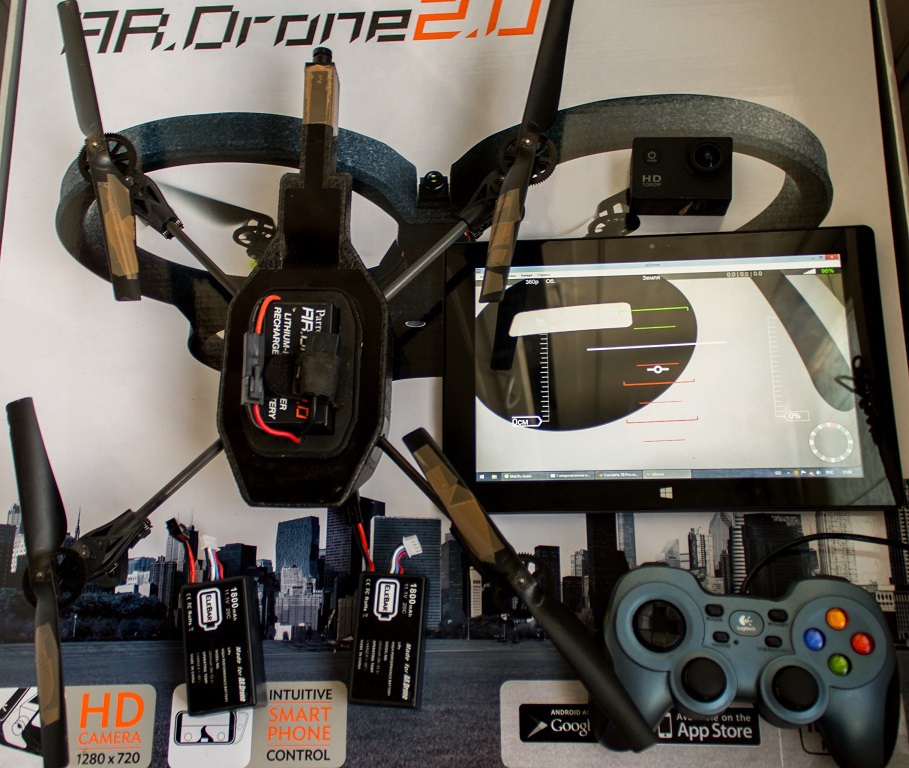Experience using AR.Drone 2.0 in conjunction with Windows
Why AR.Drone 2.0, not DJI Phantom, or Walkera
There are a huge number of quadrocopters on the market, and there are tiny, but cheap Hubsans, and quite large DJI Phantom which are considered the quadrocopter standard, and Walkera, which are optimal in price, and many other models. But how does AR.Drone stand out for me personally from all this diversity? Of course, this is WI-FI control with the possibility of real-time video transmission over it. Those. AR.Drone is the only quadrocopter that you can buy and connect to a computer without a soldering iron, and here you can do anything you like, starting from just controlling with a joystick or mouse and ending with autonomous flights based on video from the camera and 3D reconstruction of the space.
How I accustomed AR.Drone to Windows
By default, the device is supposed to be controlled from a tablet or phone (any except wp 7.8) and when buying, sellers offer to install and configure everything, but this option is not for us, and in general it’s some kind of perversion to control a quadrocopter poking into a small screen I don’t feel sticks under the fingers. After unpacking and connecting the battery for the first time, Drone immediately appeared among WI-FI networks and the laptop connected to it without any problems. It was possible to come to the software part. The development of the management program was supposed to be exclusively in C #, and the search led to two existing projects:
- AR.FreeFlight http://projects.ardrone.org/projects/show/ardrone-api
- Ruslan-B / AR.Drone http://github.com/Ruslan-B/AR.Drone
The second set of library libraries seemed to me easier to understand and not so loaded, in addition, they were desktop while AR.FreeFlight under runtime and the choice fell on Ruslan-B / AR.Drone. Moreover, surprisingly, there is still no decent program for Windows with the ability to control from a joystick or gamepad. A week of evenings spent on development and it turned out a library + program with possible control from a gamepad, telemetry output over video, calculation of flight time, sound notification and all that I needed for flights. But the most important thing is that you can use computer vision and implement an autonomous field, since the library provides video and telemetry bitmaps, and takes a control vector. I do not think that the libraries and the program should be described in this post, since this is a separate and complex topic. An example of superimposed telemetry in a photograph. The program is called IsDrone, the source code and installer are herehttp://isdrone.codeplex.com.

How and with what help do I fly
The first flight under control was made from a laptop and a gamepad, in general, everything is acceptable except for the weight of the laptop and its dimensions. A more convenient option was the use of a tablet on Windows 8.1 which easily fits in a backpack along with Drone, batteries and all other accessories. The general set for the flight looks like this.

All this fits perfectly in a small backpack from a 13-inch laptop and weighs 1 kilogram. The control is similar to mode 2, and against the background of smaller Dron quadrocopters it is very easy to control and in general it is very stable (a video of freezing on the ground is presented below). After connecting and checking the operation, the tablet is usually sent to a backpack that hangs behind the back and control is carried out by visual contact without using FPV, and sometimes the tablet is given to the hands of children, who certainly appear nearby, and they watch “live broadcast from the sky”.
Video recording
In addition to pampering and research interest, AR.Drone is also suitable for shooting video, since without additional expenses and working with a soldering iron, you get the opportunity to record video while seeing that you are real in real time (of course, not DJI Phantom with a suspension, but also a price of 5 -8 times less). But alas, the built-in Drone camera is still not of the best quality, and for recording it is better to use an additional camera such as GoPro or the Chinese analog SJ4000.
General opinion
AR.Drone 2.0 is unique with a gadget for research in the field of computer vision and robotics, which can be easily connected to a computer. In addition, it is simply a comfortable and stable quadrocopter with a very attractive price. By the way, the price in one of the stores is just 8,120 rubles, indicating its name will be an advertisement, but this is the real price, and not the 14,000 that come from many who ask in many online stores.
